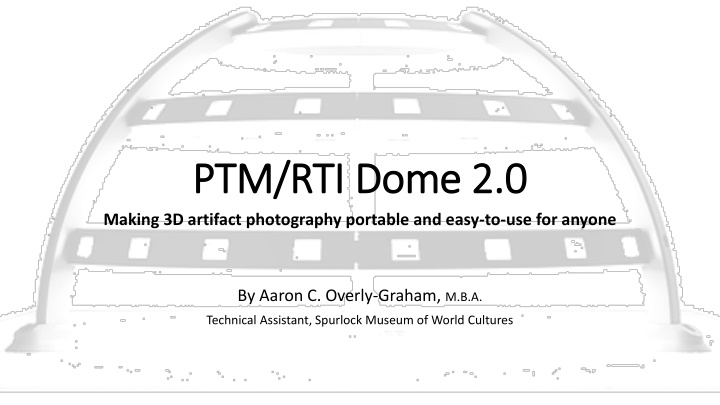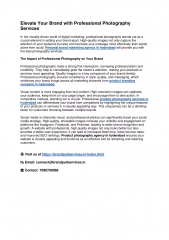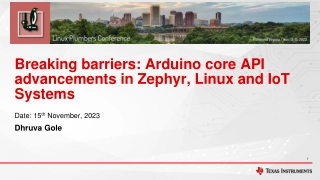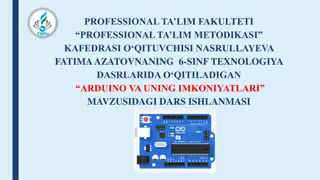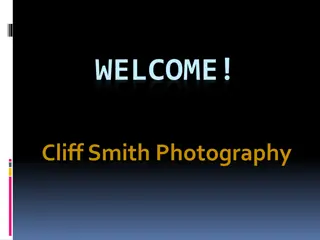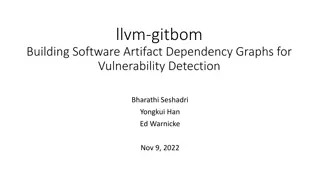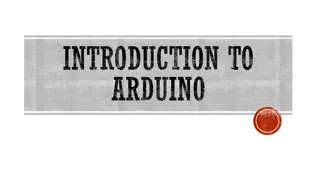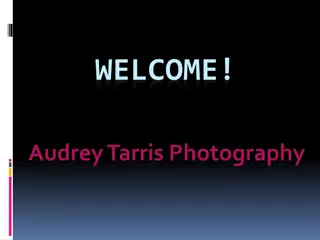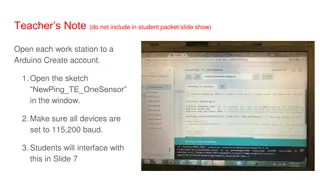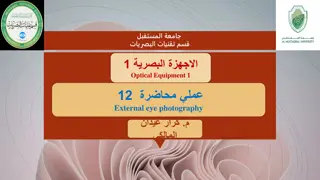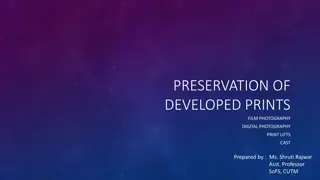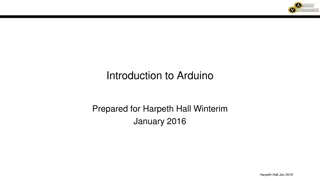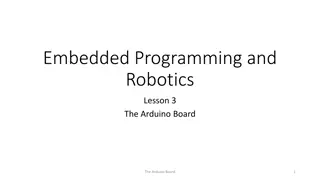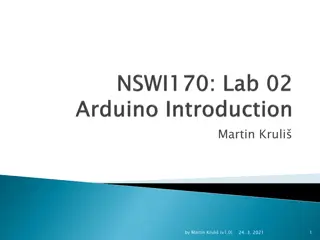Advancing 3D Artifact Photography with Arduino Technology
Transforming the traditional PTM/RTI dome setup into a more efficient and user-friendly process using Arduino-driven automation. Overcoming current technology and hardware limitations to enhance artifact documentation and preservation methods at the Spurlock Museum of World Cultures.
Download Presentation

Please find below an Image/Link to download the presentation.
The content on the website is provided AS IS for your information and personal use only. It may not be sold, licensed, or shared on other websites without obtaining consent from the author.If you encounter any issues during the download, it is possible that the publisher has removed the file from their server.
You are allowed to download the files provided on this website for personal or commercial use, subject to the condition that they are used lawfully. All files are the property of their respective owners.
The content on the website is provided AS IS for your information and personal use only. It may not be sold, licensed, or shared on other websites without obtaining consent from the author.
E N D
Presentation Transcript
PTM/RTI Dome 2.0 PTM/RTI Dome 2.0 Making 3D artifact photography portable and easy-to-use for anyone By Aaron C. Overly-Graham, M.B.A. Technical Assistant, Spurlock Museum of World Cultures
PTM/RTI and the Spurlock Museum PTM/RTI and the Spurlock Museum PTM = Polynomial texture mapping, a type of RTI (Reflectance Transformation Imaging): Uses a single camera to take photos of an object under multiple light angles. Combines those images to allow the viewer to move lighting around virtually on a 3D version of the object. Reveals hidden details and enables in-depth study. HP developed PTM in 2001 and Spurlock Museum has been using it since 2008: Allows for digital preservation of our artifact collection. Enables scholars worldwide to study artifacts in unprecedented ways without having to travel or physically access (and potentially impact) the ancient objects.
Current set Current set- -up up C = A B E D
Description of the process Description of the process The camera (A) is pointed downward and focused on an artifact placed under the dome (B) of 32 fixed LED lights. Each light (C) is turned on one at a time. A picture is taken using the camera s software on the computer (D) to operate an Arduino control box (E). The current light is then turned off, and the next one turned on. This process is repeated until all 32 images are taken. Photoshop Bridge is used to collate the image set and digitally clean up any histogram issues. A Photoshop script is run, creating the artifact s final PTM image for archival and scholarly use.
Issues Issues The technology is old: Due to successive Windows OS updates, the program that used to turn the lights on and off in succession and control the camera s shutter no longer works. This requires the entire process to be run completely manually, which increases time from c. 2 minutes to 5-10 minutes for the photo set, depending on the object. Any manual involvement in the process introduces the potential for movement, which can impact the quality of the final PTM image. The hardware set-up has issues and limitations: The dome is heavy and stationary, and has limited capacity for artifacts sizes. The LEDs wiring is not very robust, and has had a number of failure issues over the years: The 32-light set-up is only efficient if all 32 LEDs light. The current Arduino has likewise had issues due to age.
Outline of Project Request Outline of Project Request Develop a new Arduino-driven script or similar to perform the following actions at the simple push of a button:* Turn on LED #1 Open the camera s aperture to take the first photo (light angle #1) Turn off LED #1 Turn on the next LED (#2, etc. ) Repeat steps above until the full set of 32 LEDs have been run through, providing a full set of 32 images. Also enable users to manually turn on/off any light(s) in the series as may be specifically needed. Wire 32 new LEDs on our next generation, lightweight, portable PTM Dome 2.0! Ensure wiring is done with longevity in mind: We hope to have students utilize this Dome 2.0 on thousands of artifacts in our collection for many years to come. *Either a physical button, laptop, smartphone app, or Bluetooth, etc. depending on feasibility, cost, and capstone student s expertise.
Dome 2.0 Concepts Dome 2.0 Concepts * * dmkpermaculture.com rti-dome.com We are looking to coordinate the final design with the capstone student to ensure all goals are achieved: Lightweight-yet-sturdy, built-to-last design allowing for portability and photography of a larger size range of artifacts. Easy to learn how to operate. Able to quickly run repeatedly. We will provide any materials needed for completing and operating the Dome 2.0. * Please note: Our existing Canon EOS Mark III camera will be utilized in this new set-up.
Choose this project and play an integral role in advancing the future of the Spurlock Museum!
